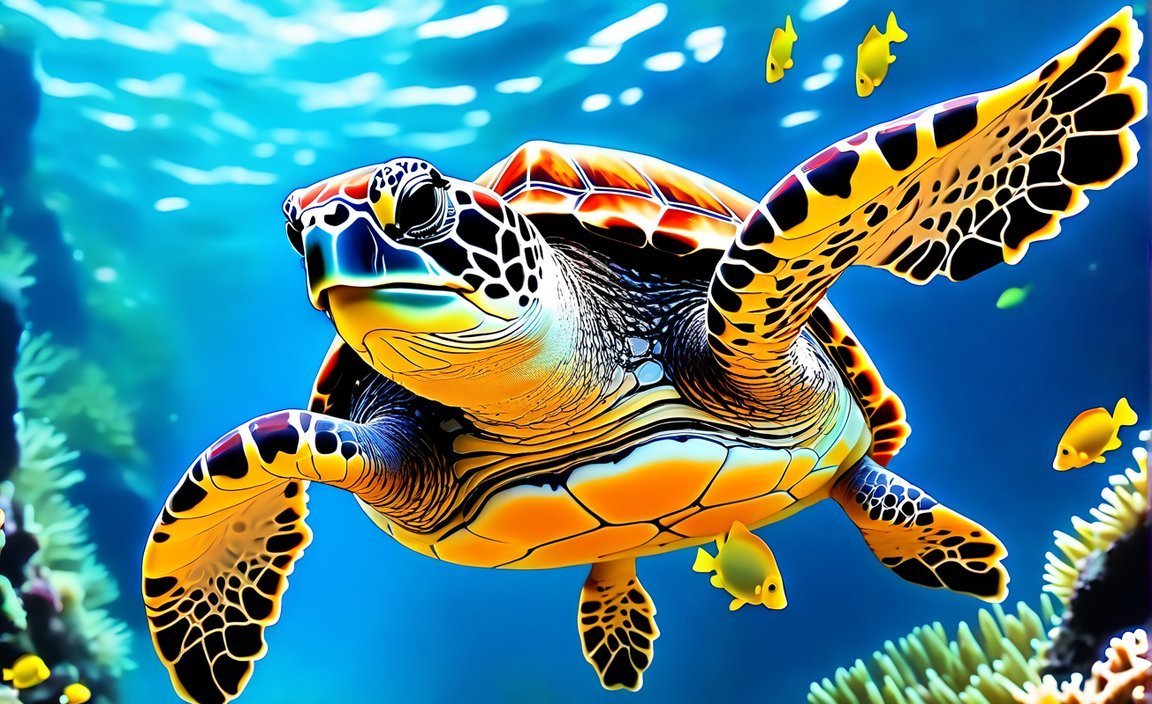If you’re a nature lover eager to delve into the captivating world of marine life, prepare to be amazed as we explore the fascinating realm of hawksbill turtles. In this article, we will uncover ten intriguing and little-known facts about these remarkable creatures, shedding light on their unique features, nesting behavior, and migratory patterns. Join us on this exciting journey as we dive deep into the ocean and discover the wonders of the hawksbill turtle.

Key Takeaways:
- The Hawksbill Sea Turtle has a distinct narrow head and a bird-like beak that helps it forage for food in coral reefs.
- Hawksbill Sea Turtles play a crucial role in maintaining the health of coral reefs by feeding on sponges.
- Female Hawksbill Sea Turtles nest multiple times per season and lay approximately 140 eggs in each nest.
- Hawksbill Sea Turtles prefer nesting in low densities on beaches, unlike other sea turtle species.
- Hawksbill Sea Turtles are the most endangered sea turtle population worldwide.
- Hawksbill turtles are named for their long, narrow head and their hawk-like beak, which they use because they have no teeth.
- The population of Hawksbill Turtles is rapidly decreasing due to habitat loss and human exploitation.
- Hawksbill Turtles can be found in warm tropical waters across the world.
- Hawksbill Turtles primarily feed on sponges, jellyfish, anemones, and other small marine animals.
- Female Hawksbill Turtles return to their birthplace to lay their eggs.
- Hawksbill Turtles help maintain coral reefs by feeding on sponges that would otherwise suffocate the corals.
- Hawksbill Turtles are biofluorescent and can absorb and emit light as a different color, although the reason for this is still unknown.
- Hawksbill Turtles have a unique ability to feed on dangerous jellyfish without harm, giving them a competitive advantage.
- Hawksbill Turtles live solitary lives and only come together to mate.
- Hawksbill Turtles can migrate long distances between their feeding and nesting areas.
- The hawksbill sea turtle is the only extant species in the genus Eretmochelys and is classified as critically endangered.
- Hawksbill turtles are medium-sized and can reach up to three feet long and weigh 300 pounds.
- The beautiful shells of hawksbill turtles have contributed to their decline due to illegal trade and poaching.
- Hawksbill turtles are more reef-associated than other sea turtle species and forage on a variety of prey found in coral reefs.
- Hawksbill Turtles are one of the smallest turtle species and are characterized by a narrow, pointed beak and heart-shaped shell.
- Hawksbill Turtles play an important role in the tourism industry, attracting divers and snorkelers with their beauty and unique behaviors.
10 Fun Facts About Hawksbill Turtles
The hawksbill turtles, with their distinctive features and unique behaviors, are truly captivating creatures. In this article, we will embark on a journey to uncover 10 fascinating facts about hawksbill turtles that will leave you in awe of these amazing sea creatures.
Fact 1: Their Unique Beak and Feeding Habits
Hawksbill turtles possess a narrow head and a sharp, beak-like mouth that resembles that of a bird. This beak is not just for show; it helps them reach into cracks and crevices of coral reefs to find their preferred food. These skilled foragers feed primarily on sponges, playing a crucial role in maintaining the health of coral reefs. Without their presence, these sponges would overwhelm the corals and suffocate the reefs. It’s incredible how they are the only known marine reptiles that can eat these toxic sponges without any harm!
Fact 2: Nesting Behavior and Reproduction
When it comes to nesting, hawksbill turtles take their time and nest at a slower pace compared to other sea turtles. They nest almost four times per season, with each nest containing around 140 eggs, and sometimes even over 200! These nests are carefully spaced out at two-week intervals. Interestingly, hawksbill turtles prefer to nest in low densities on beaches, making them solitary nesters.
Fact 3: A Critical Endangered Species
Sadly, hawksbill turtles are facing the threat of extinction. They are the most endangered sea turtle population worldwide, and their numbers continue to decline. In the United States, they are listed as Endangered due to habitat reduction, illegal animal trading, and accidental consumption of plastic, often mistaken for jellyfish. It is crucial for us to raise awareness and take action to protect these magnificent creatures.
Fact 4: Migratory Wanderers
Hawksbill turtles lead fascinating lives as they migrate long distances between their feeding and nesting areas. They can be found in warm tropical waters across the globe, including the Atlantic, Pacific, and Indian Oceans. With their nomadic nature, they grace these tropical waters and leave a lasting impression wherever they go.
Fact 5: Hawksbill Turtles and Coral Reef Health
These sea turtles play a vital role in the health of coral reefs. By feeding on sponges, they help regulate their growth, preventing them from overpowering and suffocating the corals. Their presence ensures a delicate balance in marine ecosystems, making them an important keystone species.
Fact 6: The Mystery of Biofluorescence
Hawksbill turtles have a mesmerizing ability: they are biofluorescent. This means they can absorb light and emit it as a different color. Scientists are still unraveling the mystery behind this phenomenon and its purpose in their lives. It’s like they possess their own magical light show!
Fact 7: A Heart-Shaped Shell
One cannot help but be enchanted by the hawksbill turtle’s shell. It has a distinct heart-shaped pattern, adding to its allure. Unfortunately, this beautiful shell has also become its curse, as it has contributed to the decline in their population due to illegal trade and poaching.
Fact 8: Returning to Their Birthplace
Female hawksbill turtles exhibit an incredible nesting behavior. They return to the same beaches where they were born to lay their eggs, continuing the cycle of life. It’s a remarkable instinct that keeps their connection to their birthplace strong.
Fact 9: Solitary and Strong Swimmers
Hawksbill turtles predominantly lead solitary lives. However, they do come together in the mating season. Their strong flippers make them exceptional swimmers, enabling them to navigate through the ocean with grace and agility. They truly embody strength and independence.
Fact 10: Ecotourism and Conservation Efforts
With the growing interest in marine life, hawksbill turtles have become ambassadors of conservation. Their beauty and unique behaviors attract divers and snorkelers from all over the world. Through ecotourism, we can raise awareness about their conservation needs and contribute to their protection.
Hawksbill turtles are truly remarkable creatures. From their distinct beaks and feeding habits to their crucial role in coral reef health, these sea turtles captivate our hearts and ignite our passion for their conservation. Let us join hands to protect these magnificent species and ensure they thrive for generations to come.
Check out these 10 fun facts about falcons! The magnificent creatures are known for their incredible speed and agility in the sky. Learn more about them and their fascinating behavior here.
Discover the wonders of the hawksbill sea turtle with these amazing 10 fun facts! These beautiful creatures have a unique shell pattern and are critically endangered. Dive into their captivating world here.
Hawksbill Turtles: Guardians of Coral Reefs
The stunning beauty of coral reefs fills our minds with awe and wonder. However, there is one unsung hero that works tirelessly behind the scenes to maintain the health and balance of these delicate ecosystems. Hawksbill turtles play a crucial role in maintaining the health of coral reefs by feeding on sponges and controlling their populations. Let’s dive into the fascinating world of hawksbill turtles and uncover ten incredible facts about these magnificent creatures.
Fact 1: A Hungry Appetite for Sponges
Hawksbill turtles are true connoisseurs when it comes to food. They have a passion for sponges and aren’t afraid to use their unique beak-like mouth to reach into cracks and crevices to find their favorite delicacy. With their insatiable appetite, hawksbills help prevent the overgrowth of sponges on coral reefs, thereby ensuring a healthy balance.
Fact 2: The Architects of Coral Reefs
Imagine a bustling neighborhood where every resident plays an essential role. Hawksbill turtles are the architects of coral reefs, actively contributing to their survival by controlling sponge populations. By removing sponges from the reef’s surface, hawksbills provide better access for reef fish and other marine creatures to feed and thrive.
Fact 3: World Travelers
Hawksbill turtles have a wanderlust spirit. These extraordinary creatures can be found in coral reefs throughout the world’s tropical oceans. They migrate long distances between their feeding and nesting areas in warm tropical waters across the globe. Their journeys not only demonstrate their strength and resilience but also highlight their significance in maintaining coral reef ecosystems worldwide.
Fact 4: Guardians Against Climate Change
As guardians of coral reefs, hawksbill turtles face a dual threat: climate change and habitat loss. Coral reefs, increasingly threatened by rising sea temperatures, rely on sea sponges to recover and recycle vital nutrients for their survival. By keeping sponge populations in check, hawksbills contribute to the resilience of coral reefs, ensuring they can face the challenges brought by climate change.
Fact 5: A Shell of Distinction
Hawksbill turtles are known for their distinctive heart-shaped shells, which unfortunately contribute to their decline due to illegal trade and poaching. These beautiful shells, often referred to as “tortoise shell,” are highly sought after for their ornamental and decorative purposes. Conservation efforts are necessary to protect these magnificent turtles and preserve their iconic shells.
Fact 6: Homecoming Tradition
Female hawksbill turtles possess a remarkable trait—they return to the same beaches where they were born to lay their eggs. This homecoming tradition is what ensures the cycle of life continues for these ancient creatures. By safeguarding their nesting grounds, we can play a part in protecting hawksbill turtles and giving their future generations a fighting chance.
Fact 7: Solitary Nomads
Hawksbill turtles lead a solitary existence, exerting their independence as they traverse the oceans. With their strong swimming abilities and exceptional agility, they glide through the underwater world with grace and elegance. These nomads ensure that their vital presence is felt in various marine environments, enriching the biodiversity of our oceans.
Fact 8: Biofluorescent Wonders
Hawksbill turtles possess an enchanting secret. They are biofluorescent, meaning they can absorb light and emit it as a different color. Picture an underwater aurora borealis, where these incredible creatures display vibrant hues beneath the ocean’s surface. Though the purpose behind this phenomenon remains a mystery, it adds to the captivating allure of hawksbill turtles.
Fact 9: Ambassadors of Conservation
Hawksbill turtles have become ambassadors of conservation through the power of ecotourism. People from around the world are increasingly drawn to witness these majestic creatures in their natural habitat. By engaging in responsible tourism and supporting conservation efforts, we raise awareness about the importance of protecting hawksbill turtles and their fragile ecosystems.
Fact 10: The Imperative of Conservation
In conclusion, hawksbill sea turtles are environmental warriors, playing an indispensable role in maintaining the health of coral reefs and the survival of other marine species. Their feeding habits, combined with their presence in the world’s tropical oceans, contribute to the balance and biodiversity of marine ecosystems. To safeguard the future of hawksbill turtles and coral reefs, conservation efforts must be strengthened and amplified.
Key Takeaways:
– Hawksbill turtles are key players in coral reef ecosystems, feeding on sponges and controlling their populations.
– Their unique beak-like mouth allows them to access sponges in hard-to-reach places.
– Hawksbills migrate long distances between feeding and nesting areas, showcasing their strength and resilience.
– They contribute to the survival of coral reefs by maintaining a balance essential for other marine species.
– Hawksbill turtles face threats such as climate change and illegal trade for their beautiful shells.
– By protecting their nesting grounds, we ensure the continuation of their life cycle.
– Hawksbill turtles are solitary creatures, traversing the oceans with exceptional agility.
– Their biofluorescence adds to their mystique, with vibrant colors glowing beneath the waves.
– Responsible tourism can help raise awareness about the conservation of hawksbill turtles and their habitats.
– Conservation efforts are imperative to safeguard the crucial role of hawksbill turtles in maintaining the health of coral reefs.
Sources:
– turtlebio.com
– worldwildlife.org
Their beautiful shells, known as tortoiseshell, have been highly sought after for centuries, leading to their decline in numbers.
Hawksbill turtles, also known as tortoiseshell turtles, possess a striking feature that has unfortunately led to their decline in numbers. Their beautiful shells, known as tortoiseshell, have been highly sought after for centuries due to their exquisite color and pattern. The demand for these shells has resulted in rampant poaching and illegal trade, pushing hawksbill turtles to the brink of extinction.
Despite international bans and conservation efforts, these magnificent creatures are still critically endangered. Their unique shells, which once made them highly prized, now serve as a poignant reminder of the detrimental impact of human activities on wildlife populations.
So, why are their shells so coveted? Let’s delve into some fascinating facts about hawksbill turtles:
1. The Tantalizing Tortoiseshell
Hawksbill turtles’ shells, known as tortoiseshell, are treasured for their aesthetic appeal and versatility. The unique pattern and color variations of the shells make them highly valuable and commonly sought after. For centuries, tortoiseshell has been used to create jewelry, accessories, and even decorative items.
Citation:
– National Heritage Board. Let’s Learn About Tortoiseshell. source
2. A History of Decline
Unfortunately, the popularity of tortoiseshell has had devastating consequences for hawksbill turtles. Overexploitation and uncontrolled hunting for their shells have caused a severe decline in their population. In the 1970s, recognizing the urgent need to protect these creatures, the international community implemented bans on harvesting their shells and established regulations to halt the trade of tortoiseshell products.
Citations:
– turtlebio.com. Why is the Hawksbill Sea Turtle Endangered? source
– World Wildlife Fund. Hawksbill Turtle. source
3. A Serrated Beauty
Hawksbill turtles derive their name from their distinctive beak-like mouth. Moreover, their shells feature a fascinating pattern of overlapping scales, which create a serrated appearance along the edges. These serrations add to the unique charm of their shells, making them instantly recognizable.
4. The Architects of Coral Reefs
Hawksbill turtles play a crucial role in maintaining the health and balance of coral reefs. Their preferred diet consists of sponges, which they help control by feeding on them. This regulates sponge populations, preventing them from outcompeting other reef-building organisms. By performing this vital ecological function, hawksbill turtles ensure the survival and diversity of coral reef ecosystems.
5. Mysteries of Biofluorescence
One fascinating aspect of hawksbill turtles is their ability to exhibit biofluorescence. This means they can absorb light and emit it as a different color, adding a mesmerizing glow to their shells. However, the purpose behind this phenomenon remains a mystery, intriguing scientists and captivating the imagination of nature enthusiasts.
6. A Pacific Crossroads
Hawksbill turtles are found primarily in tropical oceans worldwide, particularly in coral reef habitats. These graceful creatures migrate long distances between their feeding and nesting areas, traversing warm tropical waters with astonishing agility. Their extensive travels make them important ambassadors of marine interconnectedness and emphasize the need for transnational conservation efforts.
Citation:
– Wikipedia. Hawksbill Sea Turtle. source
7. A Call to Protect
The decline of hawksbill turtles serves as a poignant reminder of the urgent need for conservation. These enchanting creatures face myriad threats, including habitat destruction, pollution, climate change, and illegal trade in tortoiseshell products. By raising awareness about their plight and advocating for their protection, we can contribute to the preservation of these amazing animals and their invaluable role in maintaining the health of marine ecosystems.
Key Takeaways:
– The exquisite shells of hawksbill turtles, known as tortoiseshell, have been highly sought after for centuries, leading to their decline in numbers.
– International bans and conservation efforts aim to protect hawksbill turtles from exploitation and illegal trade.
– Hawksbill turtles have distinctive beak-like mouths and serrated shell edges, adding to their allure.
– These turtles play a vital role in controlling sponge populations and ensuring the health of coral reefs.
– Hawksbill turtles exhibit biofluorescence, absorbing and emitting light in different colors.
– The Pacific Ocean is a major habitat for hawksbill turtles, and they undertake impressive migrations between their feeding and nesting areas.
– Conservation efforts are essential to safeguard hawksbill turtles and preserve marine ecosystems.
Citations:
1. National Heritage Board. Let’s Learn About Tortoiseshell. source
2. turtlebio.com. Why is the Hawksbill Sea Turtle Endangered? source
Hawksbill Turtles: A Marvelous Journey Guided by Earth’s Magnetic Field
The world beneath the waves is a realm full of awe-inspiring creatures, and among them, the hawksbill turtle stands out. These remarkable sea turtles possess an incredible ability that allows them to embark on migratory journeys spanning vast distances, relying on Earth’s magnetic field as a compass. Today, we embark on a fascinating journey of discovery as we explore the top ten fun facts about hawksbill turtles.
Hawksbill Turtles: Nature’s Navigation Masters
A Magnetic Compass: Hawksbill turtles have an impressive ability to navigate long distances during their migratory journeys, using Earth’s magnetic field as a compass. This innate sense allows them to find their way across oceans, guided by the invisible forces of our planet.
Master Migrators: Hawksbill turtles are true globetrotters, traveling thousands of miles between their feeding and nesting grounds in warm tropical waters. Despite the vastness of the oceans, these magnificent creatures have an uncanny knack for returning to the exact beaches where they were born to lay their eggs.
Survival Instinct: Hawksbill turtles face numerous threats along their migratory paths. They must navigate coastal development, rising seas from climate change, pollution, and vessel strikes, which pose serious risks to their survival. Despite these challenges, hawksbill turtles persist in their quest, displaying an unwavering determination to complete their journey.
Key Takeaways:
- Hawksbill turtles possess the extraordinary ability to navigate long distances using Earth’s magnetic field as a compass.
- They undertake epic migratory journeys, returning to the same beaches where they were hatched to lay their eggs.
- Numerous threats, such as coastal development and climate change, endanger the survival of hawksbill turtles.
Let’s delve deeper into the world of these fascinating creatures.
Signs of Marvel: The Hawksbill Turtle’s Unique Characteristics
Beak-like Snout: Hawksbill turtles possess a distinctive beak-like mouth that allows them to reach into cracks and crevices with precision. This specialized snout aids them in obtaining their favorite food: sponges. By controlling sponge populations, hawksbill turtles play a crucial role in maintaining the health and balance of coral reefs.
Nature’s Architects: Hawksbill turtles are the coral reef architects. Their foraging behavior involving the removal of sponges opens up new feeding opportunities for other marine creatures. Without their expert culinary skills, coral reefs would face the challenge of limited access to food and, consequently, a decrease in biodiversity.
A Remarkable Color Show: Biofluorescence is a dazzling phenomenon displayed by hawksbill turtles. They have the ability to absorb light and emit it as a different color. Though the purpose behind this stunning showcase remains a mystery, it undoubtedly adds to the allure of these captivating creatures.
The Circle of Life: Hawksbill Turtles in Peril
Shell of Beauty: The hawksbill turtle is renowned for its distinctive heart-shaped shell. Sadly, the allure of this beautiful shell, often referred to as “tortoiseshell,” has driven illegal trade and poaching. The demand for these shells for jewelry and trinkets has pushed hawksbill turtles to the brink of extinction.
Silent Predators: From feral pigs and rats to raccoons and feral cats, hawksbill turtle hatchlings face a myriad of non-native and native predators. Eggs and hatchlings often fall victim to these silent threats, threatening the already fragile survival of these majestic creatures.
Guardians of the Ocean’s Health: Hawksbill turtles are vital to the health of coral reefs. By controlling sponge populations, they prevent the overgrowth of these organisms that could smother coral colonies. This delicate balance is essential for the resilience of coral reefs in the face of climate change and other threats.
Voices of Conservation: Hawksbill turtles have become ambassadors of conservation. Through ecotourism and public awareness efforts, these magnificent creatures draw attention to the importance of protecting their habitats and preserving marine ecosystems.
Note: Sources used for this article can be found at the following links:
- NOAA Fisheries: Hawksbill Turtle
- National Geographic: Hawksbill Turtle
Hawksbill turtles enchant us with their incredible abilities and inspire us with their determination to survive against all odds. While their journey is fraught with challenges and threats, the fate of these magnificent creatures lies in our hands. Let us rally together and take action to ensure the protection and conservation of hawksbill turtles, safeguarding their place in the intricate tapestry of our planet’s ecosystems.

FAQ
Q1: What are some unique features of hawksbill turtles?
A1: Hawksbill turtles have a distinctive narrow head and a sharp, bird-like beak that helps them reach into cracks and crevices of coral reefs to look for food. Their beak is strong and hooked, similar to a bird of prey, allowing them to crack through coral to access their preferred food.
Q2: What do hawksbill turtles feed on?
A2: Hawksbill turtles feed almost exclusively on sponges. They play a crucial role in maintaining the health of coral reefs by feeding on sponges that would otherwise overgrow and suffocate the corals. Interestingly, while these sponges are toxic to other animals, hawksbill turtles are unaffected by them.
Q3: How often do hawksbill turtles nest?
A3: Hawksbill turtles nest nearly four times per season. Each nest contains approximately 140 eggs, although some nests may contain over 200. These layings are spaced out at 2-week intervals.
Q4: Are hawksbill turtles social or solitary nesters?
A4: Unlike many sea turtles that nest in large numbers, hawksbill turtles prefer to nest in low densities on beaches. They are solitary nesters, choosing to lay their eggs individually.
Q5: Why are hawksbill turtles endangered?
A5: Hawksbill turtles are the most endangered sea turtle population worldwide. They are listed as Endangered due to habitat reduction, adults being captured for illegal animal trading, and mistakenly consuming plastic, often mistaking it for a jellyfish. These threats have significantly impacted their population.
















